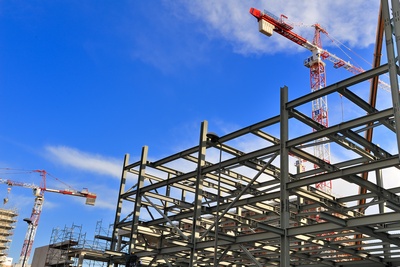
By Bernard Markstein, Ph.D.
 Despite a particularly challenging winter, construction activity has held up surprisingly well and the overall construction economy should continue to improve in the coming summer months. Construction activity typically slows during the winter and, with the unusually severe storms around the country, this winter was no exception. A good indicator that the construction economy is improving is that construction spending this winter was actually higher than last year. Year-to-date (January through April) spending for all the major groups — nonresidential buildings, heavy (civil) engineering and residential, was higher than in 2013.
Despite a particularly challenging winter, construction activity has held up surprisingly well and the overall construction economy should continue to improve in the coming summer months. Construction activity typically slows during the winter and, with the unusually severe storms around the country, this winter was no exception. A good indicator that the construction economy is improving is that construction spending this winter was actually higher than last year. Year-to-date (January through April) spending for all the major groups — nonresidential buildings, heavy (civil) engineering and residential, was higher than in 2013.
The U.S. Census Bureau reported that total construction spending rose 0.2 percent in April to $953.5 billion at a seasonally adjusted annual rate. Year-to-date not seasonally adjusted construction spending was up 8.9 percent from the same period last year.
Nonresidential building construction jumped 1.4 percent to $303.4 billion (SAAR) in April. Year-to-date NSA spending was 3.7 percent higher than the same period a year ago.
Heavy engineering (non-building) construction spending decreased 0.8 percent to $267.2 billion (SAAR) in April following a 1.1 percent advance in March. Year-to-date NSA spending was up 3.4 percent from last year.
Total residential construction spending, which includes improvements, was unchanged in April at $382.9 billion (SAAR) after increasing 1.3 percent in March. New residential construction spending, which excludes improvements, increased 1.4 percent to $234.0 billion in April, its 31st consecutive monthly increase. Compared to the same period in 2013, year-to-date NSA total residential construction spending was up 18.1 percent, and new residential construction was up 17.7 percent.
Private construction spending was essentially unchanged at a seasonally adjusted (SA) rate in April after advancing 0.7 percent in March. Year-to-date NSA spending was 13.0 percent higher than the same period in 2013.
Public construction spending rose for the second month in a row, up 0.8 percent in April after increasing 0.3 percent in March. Year-to-date NSA public spending was down 1.3 percent from last year, continuing the decline in public spending that characterized 2011, 2012, and 2013.
The State of the Economy
The nation appears to have shaken off the effects of the difficult winter. The somewhat positive construction spending data and other economic data support our view that the economy is still reasonably healthy and on an upward path. Although the Federal Reserve is reducing its purchases of long-term assets, interest rates remain low, encouraging investment. As always, there are risks to the economy and construction. These include :
- A sustained spike in interest rates due to the Federal Reserve unwinding its asset purchase program too rapidly
- Sharp reduction in government spending in the short run
- Sovereign debt default by one or more European governments
- One or more European governments abandon the Euro
- A sudden, significant increase in oil prices (beyond the somewhat elevated prices that have resulted from events in Iraq) for a prolonged period
The Forecast
The Reed forecast assumes these risks do not occur, or if they do, their effects are minimal and the economy continues to strengthen and grow at a moderate pace this year and next. As a result, nonresidential building construction is expected to gain traction and improve this year and next.
Heavy engineering (non-building) construction is also expected to continue to recover this year and be on better footing next year. More federal funding for infrastructure projects is likely to become available this year and next, although the amount is likely to be only a small down payment on what the nation truly needs. The amount of public money available for projects will be a major factor in determining infrastructure construction activity. This limiting factor will be offset by public-private partnerships at the state and local levels.
Total construction spending is forecasted to increase 9 percent in 2014 and 11 percent in 2015, with nonresidential and heavy engineering construction strengthening and residential construction continuing its recovery.
Bernard Markstein, Ph.D., is chief economist for Reed Construction Data. For more information, visit www.reedconstructiondata.com.



 Join our thriving community of 70,000+ superintendents and trade professionals on LinkedIn!
Join our thriving community of 70,000+ superintendents and trade professionals on LinkedIn! Search our job board for your next opportunity, or post an opening within your company.
Search our job board for your next opportunity, or post an opening within your company. Subscribe to our monthly
Construction Superintendent eNewsletter and stay current.
Subscribe to our monthly
Construction Superintendent eNewsletter and stay current.